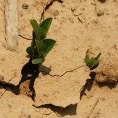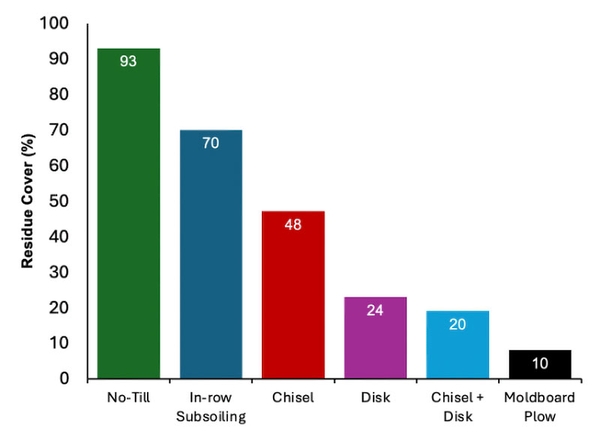Introduction
Adequate water is critical for crops to reach their yield potential. In North Carolina, periods of insufficient rainfall occur frequently and cause drought conditions for many farms across the state. Although regular, adequate rainfall is important, the ability of the soil to absorb and store water for plant use between rainfall events is also critical.
The physical properties of soil determine how much water enters the soil and how much is stored. The properties also influence how well the soil will promote root growth and allow access to the stored water. These factors can be influenced by the grower through soil management. Proper soil management increases the availability of water and provides the best opportunity for adequate water during periods of low rainfall.
Available Water Holding Capacity
All water that enters the soil is not available to plants. A range of soil wetness conditions provide optimal water availability for crop growth. We call this range the available water holding capacity of the soil. The upper limit of this range is the amount of water in the soil within one to two days after a heavy, soaking rain when the soil has had adequate time for drainage and aeration. This upper limit is the field capacity. Water that enters the soil in excess of the field capacity is not considered plant available because it either drains away quickly, or if retained by the soil, causes saturation, which may limit the exchange of oxygen and carbon dioxide to and from roots. Saturation also promotes loss of soil nitrogen via denitrification and slows the conversion of the soil’s organic nitrogen to plant available forms. The lower limit of soil wetness, plant available water, is referred to as the wilting point. At the wilting point, the amount of water that remains in the soil is held so tightly by the soil that the roots cannot extract any more water, which causes the plants to wilt.
Soil's Effect on Water Availability
Soil texture: The proportion of sand, silt, and clay-sized particles define and describe soil texture. Sand particles are the largest and tend to have larger spaces (pores) between particles. Clay particles are the smallest and have smaller pores between particles.
In sandy soils, the pores between soil particles are generally large and allow rapid drainage, which reduces water storage and lowers the water holding capacity of the sand (Figure 1). Clayey soils, in contrast, drain slowly and may also have low water holding capacity because of the small pores. Water held in these small pores is difficult for plant roots to extract. Loamy or medium-textured soils, such as a silt loam, tend to have the greatest available water holding capacity. These soils have large pores for infiltration and drainage, and medium-sized pores that store water. Water stored in these medium-sized pores can be extracted by plants. Textural influences on plant available water cannot be altered by management.
Bulk density and soil strength: Bulk density, which is a measurement of soil compaction, refers to the amount of soil in a unit bulk volume of soil. For a given soil, bulk density increases as the soil particles become compacted. Recently tilled soils tend to have a lower bulk density compared to the density before tillage. Particles in these soils are loosely packed with large pores between them. As the soil settles after tillage or is compacted by equipment traffic during a field operation, the bulk density increases. The particles are closely packed, and the pore space is limited.
Soil strength is a measure of the force required by a root to move through a soil. This can be measured with a penetrometer. In general, an increase in bulk density results in a corresponding increase in soil strength. High values for bulk density and soil strength often result in poor root growth. When root growth is impeded by high bulk density or high soil strength, the depth and length of roots are reduced because roots cannot readily access water held in the soil beyond their physical location. An example of root growth limitation from higher bulk density or soil strength in different layers of soil is shown in Figure 2.
Soil structure: Healthy soils have soil particles that are bonded together into clumps or groups, which are referred to as aggregates. The arrangement of these aggregates in the soil, along with the gaps and fissures between them, are parts of the soil structure. Adequate organic matter is usually required for good soil structure in surface horizons because it provides the ‘glue’ that holds the particles together. The spaces between the aggregates provide medium and large pores, which are important pathways for water and roots to move through the soil.
Crusting: Raindrops that strike bare soil can break the bonds that hold aggregates together, which then allows individual particles to mix and form a tight knit. After drying, this creates a dense layer at the soil surface called a surface crust (Figure 3). Soils that contain silt in the surface layer are susceptible to crusting, which prevents water from infiltrating the soil. The water runs off the soil surface and promotes erosion, rather than entering the soil to become available for the plant. This means that water from either precipitation or irrigation is wasted. Crusting also results in poor stand emergence as plants fight to break the crust that has formed.
Proper Soil Management to Increase Water Availability
The previous section described how certain soil properties affect water availability. The good news is that appropriate soil management can improve the physical properties of soil and the availability of soil water. Using optimum tillage or no tillage and managing equipment traffic patterns are two good practices.
Tillage: Tillage can affect soil water availability in a variety of ways. Certain tillage methods will create a better environment for water to enter the soil and be available to, or reached by, the plant roots.
Proper tillage methods that leave a relatively high amount of plant residue on the soil surface, such as no-till, strip-till, and cover-cropping, are beneficial because:
- Plant residues protect the soil surface from raindrop impact and prevent crusting (Figure 4).
- Plant residues slow the runoff of water that does not infiltrate immediately, which provides more time for the water to move downward and minimizes erosion.
- Plant residues minimize water evaporation, which can quickly deplete the water content of the soil near the surface.
- Decaying plant residue aids in the development of soil structure, which helps the soil absorb and hold water.
Deep tillage methods such as subsoiling can improve infiltration and root penetration by loosening the soil deep in the soil profile. In-row subsoiling leaves plant residue on the soil surface.
Conventional tillage methods that involve complete disruption of the soil surface (such as disking and bedding) can improve short-term infiltration by creating a porous surface immediately after tillage. However, problems can arise from these methods. Complete surface tillage, such as disking and cultivating, compacts soil at a depth just below the reach of the disk blades. This makes it more difficult for roots to penetrate and access water.
These tillage methods leave bare soil exposed to rainfall at the surface (Figure 5). This can lead to problems with crusting, poor emergence, poor stand, decreased water infiltration, and loss of nutrients and topsoil from runoff and erosion. Even without crusting, loose soil exposed at the surface is susceptible to erosion.
Controlled Traffic: The acts of tilling, planting, spraying, and harvesting crops obviously require equipment such as tractors and combines to move through the field. Tires cause compaction below the soil surface from the weight and pressure applied at this soil/tire interface. Up to 85% of the soil surface can be affected in one season, which leads to significant reductions in yield due to water stress caused by the root-limiting conditions associated with compaction. For more information on the effects of traffic on soil compaction, see Managing Equipment Traffic to Limit Soil Compaction (AG-439-72).
Summary
Although the inherent properties of soils may limit the amount of water absorbed or held for plants, proper management practices can provide benefits during periods of low rainfall and improve the efficiency of the irrigation programs. Tillage practices that leave crop residues on the surface and increase organic matter are beneficial because they promote infiltration and water storage. Managing traffic in a way that keeps tire tracks limited to a few inter-row positions will keep compacted surface areas to a minimum.
References
Ratliff, L.F., Joe T. Ritchie, and D.K. Cassel. 1983. “Field-Measured Limits of Soil Water Availability as Related to Laboratory-Measured Properties.” Soil Science Society of America Journal 47, no. 4:770-775.
White, Jeffrey G., Robert D. Walters, Joshua L. Heitman, Adam M. Howard, and Michael G. Wagger. 2009, November. Long-Term Conservation Tillage Effects on Physical Properties and Productivity of Southeastern U.S. Piedmont Soils. Presentation at ASA-CSSA-ASA Annual Meeting, Pittsburgh, PA.
Publication date: May 24, 2024
AG-439-77
N.C. Cooperative Extension prohibits discrimination and harassment regardless of age, color, disability, family and marital status, gender identity, national origin, political beliefs, race, religion, sex (including pregnancy), sexual orientation and veteran status.





